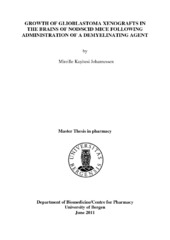| dc.description.abstract | Background: Glioblastoma multiforme (GBM) is an incurable and fatal brain cancer with short median survival. Due to the infiltrative growth into the surrounding brain parenchyma, radical surgery is not possible and their infiltrative growth patterns provide one of the biggest challenges to effective treatment. However, quite few experimental therapies targeting tumor invasion have been performed and none have prolonged survival in patients. An important mechanism underlying infiltrative growth involves the migration of tumor cells along myelinated nerve fibres (white matter tracts). Cuprizone is a neurotoxic demyelinating agent which is used to study autoimmune diseases of CNS in immunocompetent mice. Since myelinated nerve fibres provide a substrate for glioblastoma cell migration, we hypothesized that cuprizone could inhibit the infiltrative growth of glioblastoma xenografts. Since highly infiltrative brain tumor models are based on xenografting human GBM biopsies, this requires an immunodeficient host such as nude rats or SCID mice. However, whether the cuprizone model for demyelination can be established in immunodeficient strains is not known. Thus the work presented in this thesis describes the establishment of cuprizone model for demyelination in NOD/SCID mice. Subsequently, we used the model to investigate the effect of cuprizone on the growth of GBM xenografts. Method: Four NOD/SCID mice above 18 kg of weight, 4-8 weeks of age, both male and female were fed cuprizone to analyse if it caused demyelination. All mice were offered a daily portion (5 g per mice) of standard mice diet mixed with 0, 2 % cuprizone and were provided with water ad libitum. MRI was taken two, four, six and eight weeks after adding cuprizone to the diet. One brain was harvested at each time points for MRI scanning and fixed in formalin for histopathological analysis and immunohistochemistry. This analysis confirmed progressive demyelination during the diet, indicating that the cuprizone model could also be established in NOD/SCID mice. We then administered cuprizone to five more NOD/SCID mice that had been xenografted with GBM spheroids one week prior to starting the diet. These mice were compared to mice harboring GBM xenografts that received a regular diet. We then performed a second experiment where five additional mice were put on a Cuprizone diet two weeks prior to implanting them with GBM spheroids. Again these were compared with control mice that were also implanted with GBM spheroids but received a normal diet without Cuprizone. Weight and survival data were collected and the brains were harvested and fixed for the histopathological analysis and immunohistochemistry (IHC). 5 Results: Our results demonstrate that NOD/SCID mice exhibit cuprizone-induced demyelination of the corpus callosum, progressive hydrocephalus and depletion of oligodendrocyte precursor cells. Mice that were xenografted with GBM spheroids one week prior to staring the cuprizone diet did not show prolonged survival compared to the control group. However, mice that received cuprizone before GBM implantation had a significantly longer survival than the control mice. Moreover, immunohistochemistry showed less infiltration of proliferating tumor cells in the tumor periphery, as well as recruitment of microglia to both the tumor centre and periphery. Conclusion: The present study has proved that cuprizone-induced demyelination in NOD/ SCID mice provides an adequate animal model to investigate how demyelination impacts on the growth of GBM xenografts. Moreover, IHC against tumor proliferating cells after inducing demyelination show that the myelin sheaths are important substrates for glioma cell migration. Prolonged survival in the cuprizone group also suggests that interactions between glioma cells and the myelin sheaths are targets for anti-invasive glioma therapy. However, the therapeutic potential of cuprizone is highly questionable, due to its toxic effects. In contrast, novel compounds that block the attachment of glioma cells to the myelin sheath without causing structural damage, may have a big potential as anti-invasive compounds for gliomas. | en_US |
